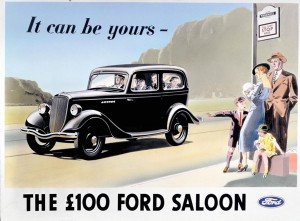How is the way we ‘consume’ the car manifest, and will the need for more environmentally friendly personal transport change our relationship with the car forever?
~
Jonathan is a PhD research student based at SURGE (Applied Research Centre for Sustainable Regeneration) here at Coventry University, researching the socio-cultural ‘consumption’ of the car and how our relationship with the car might impact upon the uptake of low carbon vehicles. A self confessed ‘treehugging petrolhead’, he is also interested in wider environmental and sustainability issues beyond the car.
The transport sector is responsible for up to 25% of all man-made carbon dioxide (CO2), emissions. The dominant source of CO2 within the transport sector is the car, which is responsible for just over half these emissions. In other words, just over 10% of all anthropogenic CO2 emissions come from the use of our beloved cars.
The need to act so as to mitigate the environmental impacts of our actions, or, as I call it, the ‘environmental imperative’, demands that we adopt a low carbon mobility to mitigate the environmental impacts of our movements. However, contemporary society – whether by dint of the spread of suburbia, various shift patterns or a fragmented public transport system seemingly run for profit and not for the public – appears to demand a low carbon automobility.
Much has been written about the costs, impracticalities and/or technologies of low carbon vehicles in academia and in the media. But how many of us think about the way in which we consume the car ‘as object’? How might the environmental impact of the car be influenced by the contemporaneous socio-cultural consumption of the car?
When I use the phrase ‘consume the car’, I don’t use it as a reference to how and why we use it; any motorist will tell you that the car is very useful, very convenient, if a bit pricey these days. Instead, I use it in reference to how we regard the car as status symbol, as icon, as cultural artefact, as avatar, as experience. I believe that how we ‘consume’ the car is fundamental to the environmental impact we have individually as motorists, because such consumption influences our choice of car, how we view the car, how we aspire to the car, how we drive the car, how we feel the car.
And why we will keep on wanting, if not needing, the car.
However, the pursuit of various low carbon automotive technologies as a means to address the environmental imperative could suggest that the nature of the car may change. In one of his columns for CAR magazine in 1996, Stephen Bayley described the car as a mature product, in that we know what it is, what it does, what to expect from it. We’ve become conditioned to the car and how it works which, in turn, impacts upon how we consume it. Yet various low carbon technologies – such as hybrids, electric vehicles (EVs), range-extended EVs, fuel cells – surely render the low carbon vehicle an immature product, in that while we may know what it is, the way in which it does it will, in some cases, be new. Low carbon vehicles may require new knowledges, new behaviours, new strategies, and also produce new experiences which, together, might impact upon how we consume the car.
As the adoption of low carbon vehicles is being left to the market and to the vagaries of consumer choice (with, admittedly, the odd governmental nudge), it is pertinent to ask whether the ways in which we use and regard the car today – our existing automobilities – can aspire to a future low carbon automobility, to find out whether irrationalities of the way in which we consume the car – our automotive peccadilloes, if you like – can be reconciled with the rationality that the environmental imperative demands. How do we consume the car? How will we reach a low carbon automobility? Do we even want to? Will we enjoy it when we get there?
To answer the question in the title of this post (which is also the working pre-title of my PhD study), we need to ascertain where ‘here’ is. I would say that ‘here’ is the latest automotive propulsion technology, whether this technology is electric, hybrid or an internal combustion engine with the low-carbon fixes and fuels, and the associated (im)practicalities of these technologies; ‘here’ is the comparatively high cost of this low carbon technology, which may well decrease over time; ‘here’ is what we know about the environmental impact of motoring and what we are prepared to do (and to pay) to mitigate and/or ameliorate it; and ‘here’ is the contemporary socio-cultural consumption of the car.
As mentioned earlier, the first definition of ‘here’ has been well documented by both academia and the technical media, as battery improvement continues apace, fuel cells are continually developed, and the internal combustion engine is constantly refined and made cleaner. In addition, the second and third definitions of ‘here’ have also been subject to a wider discourse. However, the final definition of ‘here’ is just as important, as it is through the social, cultural and experiential aspects of the car that we can begin to appraise a holistic consumption of the car. By framing the socio-cultural consumption of the car within an environmental context, and also within a technological context, it may be possible to reconcile the irrationality of car consumption with the rationality demanded by the environmental imperative, and so provide a new perspective upon the appetite and potential for low carbon automobility.
In 1957, French philosopher Roland Barthes made what now appears to be an extremely prescient observation, when he suggested that the Citroën DS may mark a change in the ‘mythology’ of cars, noting that “until now, the ultimate of cars belonged to the bestiary of power; here it becomes at once more spiritual and object-like”. The power race practised more recently by, for example, some of the German marques, together with a mindset fomented by certain TV programmes, suggests that this mythological change hasn’t been universally adopted. That said, an environmental imperative fostered by the threat of climate change suggests that a change in our automotive perceptions may be overdue. Might an environmental awareness acquire such a status within automobility that supplants the ‘bestiary of power’ of which Barthes writes?
Any changes in the way we consume the car may provide an appropriate answer. As a result of my PhD, I hope to have answers to some of the above questions in due course.
~
This article previously appeared on the author’s blog. A version of this article had also previously appeared on the Cartechnical website. You can follow Jonathan on Twitter (@jeckythump) and you can find his blog at: http://autohabitus.wordpress.com/



Comments are disabled